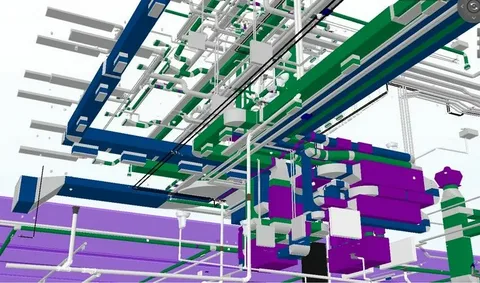In the world of construction, strength and precision are everything. Every building, bridge, or structure depends on materials that can handle heavy loads and last for decades. Two of the most important materials in this process are Precision Strand and Rebar. These materials help make concrete stronger and more reliable.
With the help of new technologies like Bentley BIM, engineers now design, plan, and manage construction projects with much more accuracy. Together, strong materials and modern software create buildings that are safer, more efficient, and built to last.
Understanding Precision Strand and Its Uses
Precision Strand is a type of high-strength steel wire used mainly in concrete construction. It is often made of several steel wires twisted together to form a single strong strand. These strands are designed to handle tension — meaning they can be pulled or stretched without breaking.
Precision strands are commonly used in prestressed concrete — a method where steel strands are stretched before the concrete is poured. Once the concrete sets, the strands are released, putting the structure under compression and making it extremely strong.
Main uses of Precision Strand:
- Bridges and flyovers
- Large concrete slabs and beams
- Parking structures
- Precast concrete elements
- High-rise buildings
These strands help reduce cracks and keep concrete tight and strong even under heavy loads.
What Is Rebar and Why It’s Important
Rebar (short for “reinforcing bar”) is another essential construction material made of steel. It’s used inside concrete to add strength and stability. Unlike steel strands, rebar is not stretched — it’s placed directly into the concrete to resist tension.
Rebar has ridges on its surface, helping it bond firmly with concrete. This bond prevents the concrete from shifting or cracking when it faces heavy pressure. Rebar is used in nearly every kind of structure, from small houses to massive bridges.
Common applications of rebar:
- Foundations and footings
- Walls and columns
- Slabs and floors
- Bridges and tunnels
- Industrial plants
Together, Precision Strand and Rebar make concrete much stronger and more durable, giving engineers the confidence to build taller and safer structures.
The Difference Between Precision Strand and Rebar
While both materials strengthen concrete, they work in slightly different ways. Precision Strand is used in prestressed concrete, while Rebar is used in reinforced concrete. Understanding this difference is important for every builder and engineer.
Precision strands apply internal force that keeps concrete compressed and crack-free. Rebar, on the other hand, provides external support that resists pulling forces and holds the structure together when it’s loaded.
Quick comparison:
- Precision Strand: Used in prestressed concrete; provides internal tension.
- Rebar: Used in reinforced concrete; resists external stress.
- Precision Strand: Smooth and flexible steel wires.
- Rebar: Solid steel rods with ridged surfaces.
Both materials have their own strengths, and most modern structures use a combination of both to achieve maximum safety and performance.
How Bentley BIM Improves Construction Accuracy
Modern construction relies not just on strong materials but also on smart technology. Bentley BIM (Building Information Modeling) is a powerful software platform that helps engineers design and manage construction projects digitally.
Using Bentley BIM, teams can create 3D models of structures that include all details — from rebar placements to precision strand layouts. This technology allows engineers to detect design errors early, avoid clashes, and save time during construction.
Benefits of Bentley BIM in projects:
- 3D visualization of design and structure
- Accurate placement of rebar and strands
- Early clash detection between building systems
- Better coordination among architects and engineers
- Cost and material management through digital planning
By combining Precision Strand and Rebar with Bentley BIM, construction companies can achieve better precision, safety, and cost control in every project.
Role of Precision Strand and Rebar in Structural Strength
Concrete alone is strong in compression but weak in tension. That’s why Precision Strand and Rebar are added — to give the structure complete strength. The strands take care of tension forces, while rebar supports bending and shear forces.
In modern buildings, engineers use both materials together to balance the load. This helps prevent cracks, sagging, or failure under stress. With this combination, bridges, towers, and industrial structures become much stronger and safer to use.
Benefits of combining both materials:
- Prevents cracking and bending
- Increases lifespan of structures
- Reduces maintenance costs
- Makes structures more resistant to earthquakes and heavy loads
Bentley BIM and the Future of Reinforced Concrete Design
Technology like Bentley BIM is changing the future of concrete design. Instead of working on 2D drawings, engineers can now build complete digital models before starting construction. These models show where every Precision Strand and Rebar should be placed, how they interact, and how much material is needed.
This process saves both time and money. It reduces human error, helps with faster approvals, and improves collaboration between teams. In large projects like highways or metro systems, BIM ensures perfect coordination among civil, structural, and MEP teams.
Advantages of BIM in concrete design:
- Better visualization of internal steel layout
- Real-time updates and design modifications
- Accurate quantity take-offs for rebar and strands
- Improved safety and compliance with standards
Quality Control and Material Standards
Every Precision Strand and Rebar used in construction must meet strict quality standards. The steel used must have the right strength, flexibility, and resistance to corrosion. Using low-quality materials can cause cracks or failure in structures.
That’s why many engineers now depend on Bentley BIM and similar systems to track quality and performance digitally. From manufacturing to installation, BIM software keeps a digital record of all materials, ensuring that every part meets required standards.
Quality checks include:
- Testing steel strength
- Checking strand diameter and coating
- Verifying correct rebar placement in BIM models
- Recording batch numbers for traceability
By using both strong materials and reliable technology, construction projects maintain high safety and durability standards.
Building the Future with Strength and Technology
The combination of Precision Strand, Rebar, and Bentley BIM represents the future of modern construction. Strong materials provide durability, while digital tools bring accuracy and smarter planning. Together, they reduce waste, cut costs, and make construction safer.
As cities grow and new infrastructure projects begin, these materials and technologies will remain at the heart of every successful structure. Builders, engineers, and designers who adopt them early will lead the way in innovation and quality.
The future looks like this:
- Smarter buildings with digital models
- Stronger materials with improved testing
- Faster construction with fewer errors
- Sustainable design for long-term durability
Conclusion
In modern construction, Precision Strand and Rebar are not just materials — they are the backbone of strength and stability. They make concrete stronger, safer, and longer-lasting. And with the help of Bentley BIM, engineers can plan every detail with precision, reducing mistakes and improving quality.
Whether it’s a high-rise building, a bridge, or an industrial plant, these tools and materials work together to create structures that stand tall for generations. The future of construction is smart, strong, and sustainable — built on steel, concrete, and technology.
https://zynrewards.org/




Leave a Reply